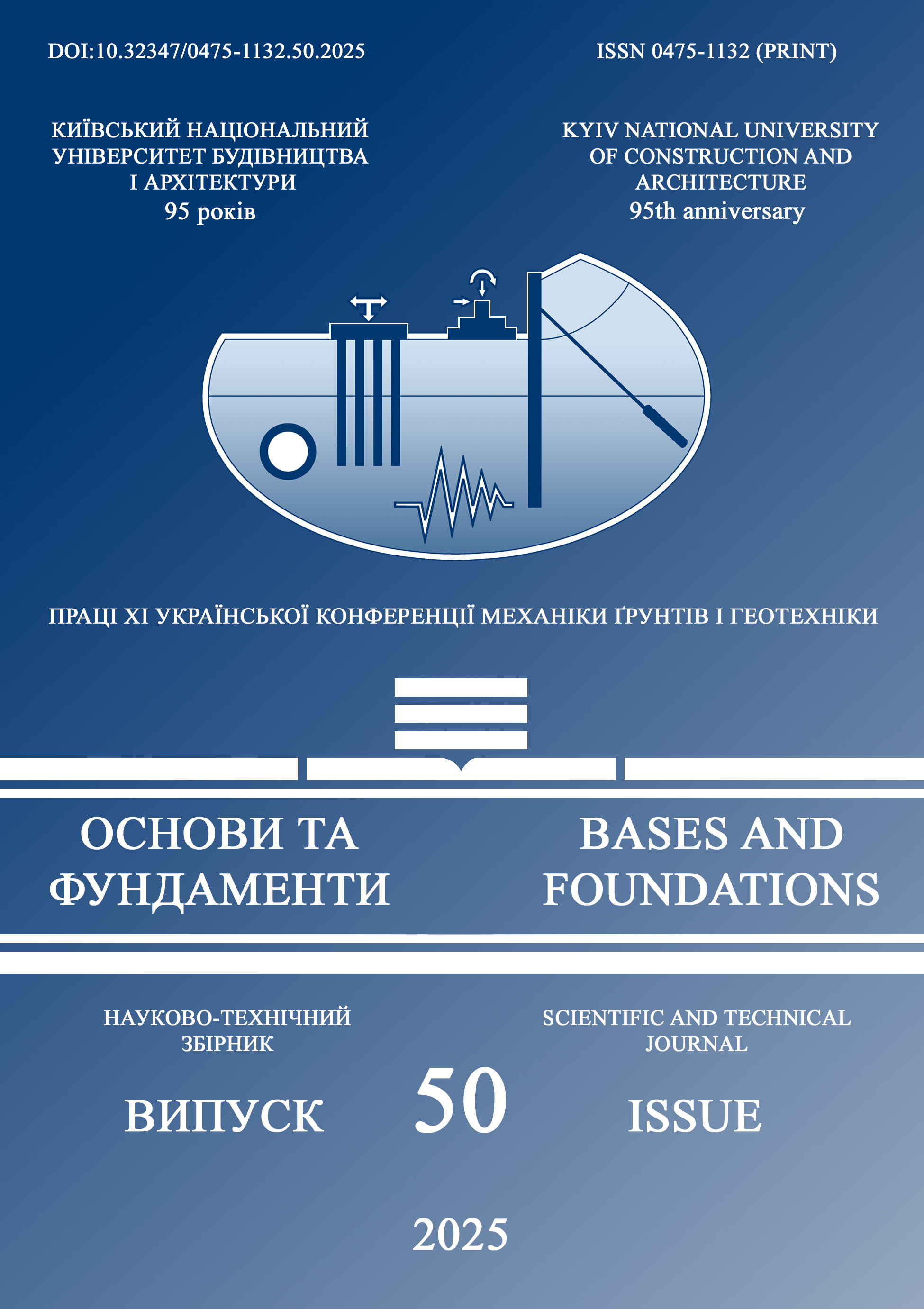Особливості будови карпатського флішу та сучасні методи оцінки його фізико–механічних властивостей
Основний зміст сторінки статті
Анотація
Карпатський фліш є складною геологічною товщею, що характеризується чергуванням пісковиків, алевролітів і глинистих сланців, значною тріщинуватістю та анізотропією механічних властивостей. Ці особливості суттєво впливають на формування геологічних процесів, включаючи оцінку стійкість схилів, визначення несучої здатності та ймовірність розвитку зсувних деформацій. Вивчення фізико-механічних параметрів флішу є важливим завданням, оскільки вони визначають поведінку порід під дією природних і техногенних факторів.
У роботі проаналізовано сучасні методи оцінки механічних характеристик карпатського флішу, що включають лабораторні та польові дослідження. Польові методи (SPT, CPTu, пресіометричні випробування, скельні дилатометри, геофізичні дослідження) дозволяють оцінити опір ґрунтів, параметри міцності та інші важливі параметри безпосередньо у природному заляганні. В роботі досліджено можливість виконання динамічного і статичного зондування в умовах карпатського флішу. Геофізичні методи, зокрема сейсмоакустичні випробування, електророзвідка та георадарні дослідження, дозволяють отримати інформацію про можливі розміри деградованої зони, непряму оцінку міцності та тріщинуватості порід на значних глибинах Лабораторні дослідження (одновісний стиск, зсувні випробування) забезпечують детальний аналіз структурних особливостей та поведінки матеріалу при різних навантаженнях.
Окрему увагу приділено числовому моделюванню механічної поведінки флішу. Розглянуто основні числові моделі, які можливо застосувати для моделювання флішових порід, зокрема лінійно–пружні, пружно–пластичні, гіпопластичні та моделі, які враховують анізотропію. Враховано переваги використання анізотропних моделей матеріалу, що дозволяють більш точно оцінювати вплив орієнтації шаруватості на міцнісні та деформаційні властивості флішу.
В результаті, можна зробити висновок, що комплексний підхід, який поєднує лабораторні, польові методи та числове моделювання, є найефективнішим для оцінки механічних характеристик флішу. Отримані дані можуть бути використані для прогнозування стійкості схилів, розробки заходів стабілізації та проєктування інженерних споруд у регіонах із флішовими відкладами.
Блок інформації про статтю

Ця робота ліцензується відповідно до Creative Commons Attribution 4.0 International License.
Автори, які публікуються у цьому журналі, погоджуються з наступними умовами: Автори залишають за собою право на авторство своєї роботи та передають журналу право першої публікації цієї роботи на умовах ліцензії Creative Commons Attribution License, котра дозволяє іншим особам вільно розповсюджувати опубліковану роботу з обов'язковим посиланням на авторів оригінальної роботи та першу публікацію роботи у цьому журналі. Автори мають право укладати самостійні додаткові угоди щодо неексклюзивного розповсюдження роботи у тому вигляді, в якому вона була опублікована цим журналом (наприклад, розміщувати роботу в електронному сховищі установи або публікувати у складі монографії), за умови збереження посилання на першу публікацію роботи у цьому журналі. Політика журналу дозволяє і заохочує розміщення авторами в мережі Інтернет (наприклад, у сховищах установ або на особистих веб-сайтах) рукопису роботи, як до подання цього рукопису до редакції, так і під час його редакційного опрацювання, оскільки це сприяє виникненню продуктивної наукової дискусії та позитивно позначається на оперативності та динаміці цитування опублікованої роботи (див. The Effect of Open Access).Посилання
Бара́нник, О. (2018). Особливості форму-вання морфогенетичних властивостей гір-сько-лучно-буроземних ґрунтів Чорногір-ського масиву Українських Карпат. Вісник Львівського університету. Серія географі-чна.
Rossi, M., & Brambilla, L. (2018). Lithological characteristics and engineering properties of flysch deposits in the Northern Apennines, Italy. Journal of Engineering Geology.
García, L., & Fernández, M. (2020). Mechanical behavior of flysch rocks: A case study from the Pyrenees. Rock Mechanics and Rock Engineering.
Kováčik, J., & Kováč, P. (2016). Landslides in flysch zones of the Western Carpathians. Geographia Slovaca.
Hoek, E., Carranza-Torres, C. T., & Corkum, B. (2002). Hoek-Brown failure criterion – 2002 edition. In Proceeding of the 5th North American Rock Mechanics Symposium (Vol. 1, pp. 267–273). Toronto, Canada.
Rocscience Inc. (n.d.). Rocscience software documentation. Rocscience. Retrieved from https://www.rocscience.com.
Barannyk, O. (2018). Osoblyvosti formuvannya morfohene-tychykh vlastyvostei hirs'ko-luchno-burozemnykh hruntiv Chornohirs'koho masyvu Ukraïns'kykh Karpat. Visnyk L'vivs'koho universytetu. Seriya heohrafichna.
Rossi, M., & Brambilla, L. (2018). Lithological characteristics and engineering properties of flysch deposits in the Northern Apennines, Italy. Journal of Engineering Geology.
García, L., & Fernández, M. (2020). Mechanical behavior of flysch rocks: A case study from the Pyrenees. Rock Mechanics and Rock Engineering.
Kováčik, J., & Kováč, P. (2016). Landslides in flysch zones of the Western Carpathians. Geographia Slovaca.
Hoek, E., Carranza-Torres, C. T., & Corkum, B. (2002). Hoek-Brown failure criterion – 2002 edition. In Proceeding of the 5th North American Rock Mechanics Symposium (Vol. 1, pp. 267–273). Toronto, Canada.
Rocscience Inc. (n.d.). Rocscience software documentation. Rocscience. Retrieved from https://www.rocscience.com.
